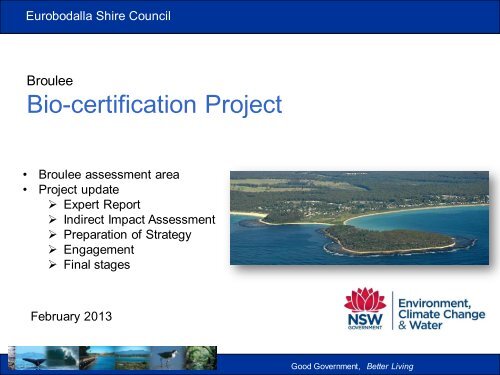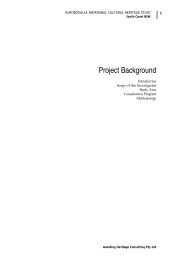Biocertification Briefing Feb 2013 - Eurobodalla Shire Council
Biocertification Briefing Feb 2013 - Eurobodalla Shire Council
Biocertification Briefing Feb 2013 - Eurobodalla Shire Council
Create successful ePaper yourself
Turn your PDF publications into a flip-book with our unique Google optimized e-Paper software.
<strong>Eurobodalla</strong> <strong>Shire</strong> <strong>Council</strong><br />
Broulee<br />
Bio-certification Project<br />
• Broulee assessment area<br />
• Project update<br />
Expert Report<br />
Indirect Impact Assessment<br />
Preparation of Strategy<br />
Engagement<br />
Final stages<br />
<strong>Feb</strong>ruary <strong>2013</strong><br />
Good Government, Better Living
<strong>Eurobodalla</strong> <strong>Shire</strong> <strong>Council</strong> Development Area<br />
Airport 33Ha Broulee 36Ha<br />
Good Government, Better Living
<strong>Eurobodalla</strong> <strong>Shire</strong> <strong>Council</strong> Offset areas<br />
~69Ha development<br />
~400Ha offset<br />
Good Government, Better Living
<strong>Eurobodalla</strong> <strong>Shire</strong> <strong>Council</strong> Credit outcomes<br />
Improve or maintain test met<br />
Improve or maintain test met<br />
Impact on 69Ha<br />
363Ha conservation land<br />
Red flag variation required<br />
Impact on 69Ha habitat<br />
372Ha conservation lands<br />
Red flag variation required<br />
Good Government, Better Living
<strong>Eurobodalla</strong> <strong>Shire</strong> <strong>Council</strong> indirect impacts<br />
Fuel management zone - 30m<br />
Good Government, Better Living<br />
OLS
<strong>Eurobodalla</strong> <strong>Shire</strong> <strong>Council</strong> indirect impacts<br />
White footed dunnart:<br />
Limited flexibility when assessing species credit species<br />
Good Government, Better Living<br />
• DCP<br />
• Minor in nature<br />
• Already in action<br />
• Floristic and<br />
structural<br />
benchmarks for<br />
BSF are broad –<br />
unlikely to detect<br />
via site value<br />
score change<br />
10m interface zone<br />
used to calculate<br />
credit reduction<br />
Exotic plant attribute<br />
reduced by 1
<strong>Eurobodalla</strong> <strong>Shire</strong> <strong>Council</strong> Expert Report<br />
Expert report:<br />
• Comment on likely presence<br />
• Estimate of number of individuals or<br />
area of habitat<br />
• Demonstrate what info was<br />
considered in making a determination<br />
Elizabeth Ashby Keystone Ecological<br />
‘the offset areas are overwhelmingly similar to the sites<br />
where Sminthopsis leucopus had been captured’<br />
‘… (it is my opinion) that they should occur in all of the<br />
habitats other than the riparian, wetland and estuarine<br />
areas and those patches dominated by weeds’<br />
Session 2: August 2012<br />
(3 additional pitfall lines - No elliot traps)<br />
Threatened species profile database:<br />
White Footed Dunnart<br />
cant withstand further loss<br />
Good Government, Better Living<br />
Session 1: early July 2012
<strong>Eurobodalla</strong> <strong>Shire</strong> <strong>Council</strong><br />
Conservation measure: permanently managed (not funded) 90%<br />
• Property Vegetation Plan<br />
• Plan of Management + s88b covenant<br />
Management actions:<br />
• Management of grazing for conservation<br />
• Weed control<br />
• Management of fire for conservation<br />
• Management of human disturbance<br />
• Retention of regrowth<br />
• Replanting or supplementary planting where natural regeneration will not be sufficient<br />
• Retention of dead timber<br />
• Erosion control<br />
• Retention of rocks<br />
Management actions<br />
Additional Management actions : Threatened species profile database sminthopsis leucopus<br />
• Control feral predators and rabbits<br />
• Apply mosaic pattern hazard reduction techniques to ensure the same<br />
areas are not burned continuously<br />
• Retain standing and fallen timber and other nest sites in areas of habitat<br />
• Avoid overgrazing by stock in areas of habitat<br />
• Apply forestry regimes that maintain floristic and structural diversity<br />
• Prevent domestic cats and dogs from roaming in habitat areas<br />
• Protect habitat and retain linkages across the broader landscape<br />
Good Government, Better Living
<strong>Eurobodalla</strong> <strong>Shire</strong> <strong>Council</strong><br />
• Determine assessment area<br />
• Biodiversity values established via survey<br />
• Credit calculations undertaken<br />
• Draft Strategy prepared<br />
• Exhibition of Strategy<br />
• Community comments reviewed<br />
• Adoption by <strong>Council</strong><br />
• Submission to Office of Environment and<br />
Heritage (OEH)<br />
• OEH assesses against Methodology<br />
• Minister makes Certification Order<br />
Process and Roles<br />
Good Government, Better Living<br />
Stage 1<br />
Assessment<br />
Stage 2<br />
Planning<br />
Stage 3<br />
Certification
<strong>Eurobodalla</strong> <strong>Shire</strong> <strong>Council</strong><br />
Good Government, Better Living<br />
Bangalay Sand Forest
<strong>Eurobodalla</strong> <strong>Shire</strong> <strong>Council</strong><br />
Threatened Species<br />
38 threatened species<br />
(threatened species tool – Biometric)<br />
Threatened Species occurring<br />
within 3km of the site:<br />
36 Birds, 1 Amphibian, 11<br />
Mammals, 1 Plant<br />
(NSW Wildlife Atlas & fauna survey records)<br />
Good Government, Better Living
<strong>Eurobodalla</strong> <strong>Shire</strong> <strong>Council</strong><br />
Voluntary alternate pathway<br />
Assessment difficulties<br />
Sustainable development principles<br />
Conflicting planning requirements<br />
1. Avoid impacts<br />
2. Minimise impacts<br />
3. Offset impacts<br />
•provide certainty to landowners<br />
•streamline the development assessment/approval process<br />
•save time and money spent on individual flora and fauna studies<br />
•negotiating individual conservation outcomes is resource intensive<br />
& slow<br />
•secure conservation outcomes for high value natural environments<br />
•strategically target mitigation or offset efforts<br />
•Reduction in cumulative impacts<br />
•ensure consistency in assessment and survey standards<br />
Good Government, Better Living<br />
project rationale
















